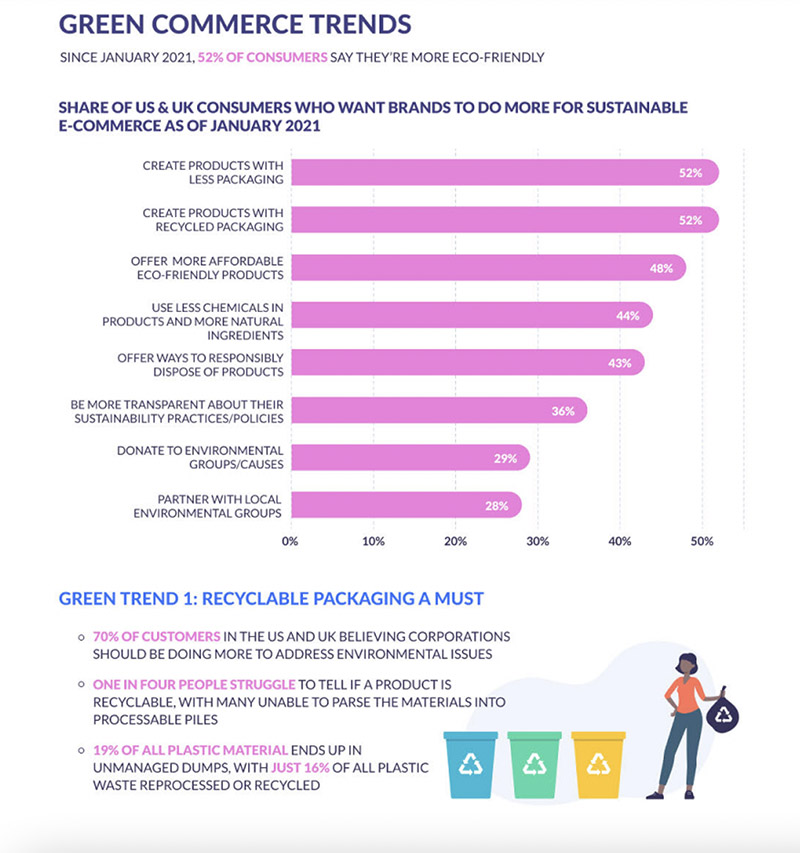Green e-commerce is a new trend within the world of e-commerce in which online businesses that follow practices and use sales methods, including packaging and shipping, to reduce their impact on the environment. According to the 2019 Connected Shoppers Report published by Salesforce, more than half of shoppers (56%) say that sustainability and ethical business practices are essential.
Whether a brand was sustainable or followed environmentally friendly practices was a minor factor in the shopping experience in the past. However, attitudes are changing rapidly. Ecologically conscious shoppers are fast becoming mainstream, impacting the margins of those not considered sustainable brands.
Sustainability can also be considered a competitive advantage. Your brand will attract a new audience looking for committed brands and increase customer retention among your current customers. Besides, sustainability has been proven to drive higher ROI and revenue.
Today’s consumers, especially Gen Z, stress the importance of sustainability, and big retail brands have started to listen to them. For example, Patagonia has publicly committed to being carbon neutral by 2025. In addition, the Body Shop avoids using plastic in delivery packaging and offers customers in-store credit when they return five product containers for recycling.
What can your brand do to join the green e-commerce trend? Here are some actions that you can start implementing to include sustainability in the ethos of your brand in 2022:
Delivery options
Implementing shipping management is one of the easiest ways to start minimising your environmental impact. Offering reserve and store pickup as alternatives are greener delivery options than direct shipping from a distribution centre. Also, customers tend to buy more products to search for everything on the same day. Shipping products directly from the store reduces carbon emissions and enables same-day delivery.
Sustainable packaging
As discussed above, The Body Shop avoids plastic in shipping its products. This and other brands prefer corrugated cardboard and recycled paper for packaging. Also, if your products come in plastic bottles, offer your customers incentives to recycle them and earn credits or points that can be redeemed for discounts.
Subscription models
Subscription models can increase a brand’s profits (up to 40%) and incentivise sustainability. For example, the first shipment may include returning used containers for recycling. Also, these subscriptions can be picked up in-store at a lower price than if shipping is included. Plus, replenishment items can be shipped in lower-cost, recyclable packaging.
Transparency
According to data published by Social Media Today, one in four consumers in the United Kingdom have difficulty determining whether a product is recyclable or not, and most cannot separate them correctly.
This means that the greater transparency, the greater confidence in a brand’s commitment to sustainability. Lately, convenience and price are not the only deciding factors in the buying process. Consider including information about your products on labels, packaging, and your website to implement transparency.
Brands like Lush fight animal testing, shop ethically and reduce waste with unpackaged cosmetics. In addition, lush is transparent about its product and shares details about its commitment on its packaging, home page, and content.
Communicate your commitment and invite your consumers to take part
Your consumers will welcome any initiative that supports sustainability. For example, communicate all your brand’s actions to reduce the environmental impact and be more ecologically friendly. Also, ask your consumers to recycle your packaging, select store pickup or recycled packaging, or include the option to donate money to organisations that fight global warming or animal testing.









